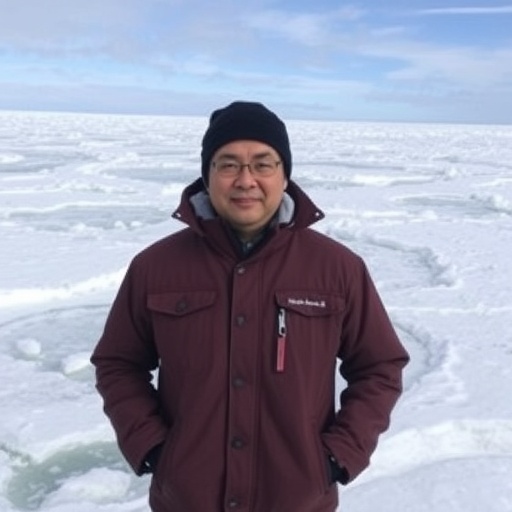In a groundbreaking development at the intersection of climate science and oceanography, researchers from Pusan National University in South Korea have unveiled unprecedented insights into how the decline of sea ice in polar regions is dramatically intensifying ocean mixing processes. This intensification, concentrated in both the Arctic and Southern Oceans, is poised to redefine our understanding of heat distribution, nutrient cycling, and pollutant transport in these fragile ecosystems under the pressures of global warming.
Ocean stirring, or the process by which ocean currents create turbulence and mix water masses, is an essential driver of the planet’s climate system. On a horizontal scale ranging from tens to hundreds of kilometers, this phenomenon is known as mesoscale horizontal stirring (MHS). It plays a pivotal role in shaping marine ecosystems by redistributing heat, nutrients, and dissolved substances such as microplastics—substances whose fate is increasingly critical for global ocean health.
Despite its importance, the intricate dynamics of MHS in polar oceans have long remained shrouded in mystery. The harsh and remote nature of polar environments restricts direct observations, while satellite data often lack the spatial resolution to capture the smaller-scale currents and eddies responsible for mixing. Moreover, traditional climate models typically do not resolve these mesoscale features adequately, limiting their ability to predict changes in oceanic stirring under future warming scenarios.
To bridge this knowledge gap, an international team led by Professor June-Yi Lee, doctoral candidate Gyuseok Yi, and Professor Axel Timmermann leveraged cutting-edge computational advancements to perform ultra-high-resolution simulations using the Community Earth System Model version 1.2.2 (CESM-UHR). These simulations, executed on the powerful Aleph supercomputer at the Institute for Basic Science in Daejeon, integrated fully coupled components representing the atmosphere, sea ice, and ocean to realistically portray interactions governing MHS.
Their analyses reveal a marked intensification of mesoscale horizontal stirring in polar regions as atmospheric CO₂ concentrations double and further quadruple, consistent with aggressive greenhouse warming pathways. This enhanced stirring arises mainly from the accelerated loss of sea ice, which exposes the ocean surface to direct wind forcing, thereby energizing the flow of ocean currents and stimulating increased turbulent activity.
In the Arctic Ocean, the retreat of sea ice unveils vast expanses of open water that become more susceptible to wind-driven mixing. This process increases eddy generation and disrupts stratification, leading to heightened horizontal stirring. Meanwhile, in the Southern Ocean, particularly along the Antarctic coast, melting glaciers contribute fresh water that alters density gradients in the ocean. These gradients reinforce currents including the Antarctic Slope Current, which, in turn, strengthens mesoscale turbulence and horizontal water parcel dispersion.
A central analytical tool employed by the team, the finite-size Lyapunov exponent (FSLE), quantifies how neighboring water parcels diverge over time — a precise measure of stirring intensity. FSLE maps illustrated a clear and persistent increase in horizontal stirring rates across both polar basins, mirroring the loss of sea ice and ecosystem exposure to dynamic environmental changes. This finding signals a potential shift in how nutrients circulate and how biological communities—plankton and fish larvae alike—are transported in these rapidly warming seas.
The cascading consequences of enhanced MHS extend beyond physical oceanography. Increased mixing can alter nutrient availability in surface waters, potentially modulating plankton blooms that comprise the base of the marine food web. Simultaneously, the redistribution of microplastics and other pollutants may accelerate their spread within these sensitive environments, posing unknown risks to marine organisms and food security.
Professor Lee emphasizes that understanding the intensification of mesoscale stirring is essential for developing robust climate adaptation policies. “Our study highlights the interconnectedness of physical changes in the ocean with biological responses and pollutant dynamics,” she notes, underscoring the importance of integrated Earth system models that can inform decision-makers seeking to mitigate climate risks.
Looking forward, the ICCP research group plans to incorporate explicit biological models of plankton and fish alongside their physical simulations. This integration aims to unravel the feedback loops between climate-driven ocean stirring and ecosystem responses, offering a more holistic view of the polar marine environment under climate change pressures.
Professor Timmermann envisions this next generation of Earth system models as transformative tools. “By coupling biological processes with climate physics at ultra-high resolutions, we will obtain unprecedented insights into how life in polar oceans adapts or succumbs to warming. This knowledge is vital for preserving biodiversity and managing marine resources,” he explains.
The emergent picture from this research underscores the accelerating pace of change in Earth’s polar frontiers. As sea ice recedes, the ocean’s internal dynamics shift towards a state of greater turbulence and mixing, reshaping the physical and biological fabric of these ecosystems. Addressing these alterations is crucial not only for scientific understanding but also for guiding international climate policy and conservation strategies.
With global CO₂ levels continuing to rise, these detailed simulations serve as a stark reminder of how interconnected the climate system truly is. The work from Pusan National University exemplifies the power of advanced computational modeling in capturing the fine-scale processes that drive large-scale environmental change, marking a significant step forward in our effort to anticipate and respond to the challenges of a warming world.
Subject of Research:
Article Title: Future mesoscale horizontal stirring in polar oceans intensified by sea ice decline
News Publication Date: 5-Nov-2025
Web References: http://dx.doi.org/10.1038/s41558-025-02471-2
References: Nature Climate Change, DOI: 10.1038/s41558-025-02471-2
Image Credits: Professor June-Yi Lee, Pusan National University, Korea
Keywords: Sea ice, Oceans, Oceanography, Ocean chemistry, Ocean physics, Ocean waves, Ocean circulation




